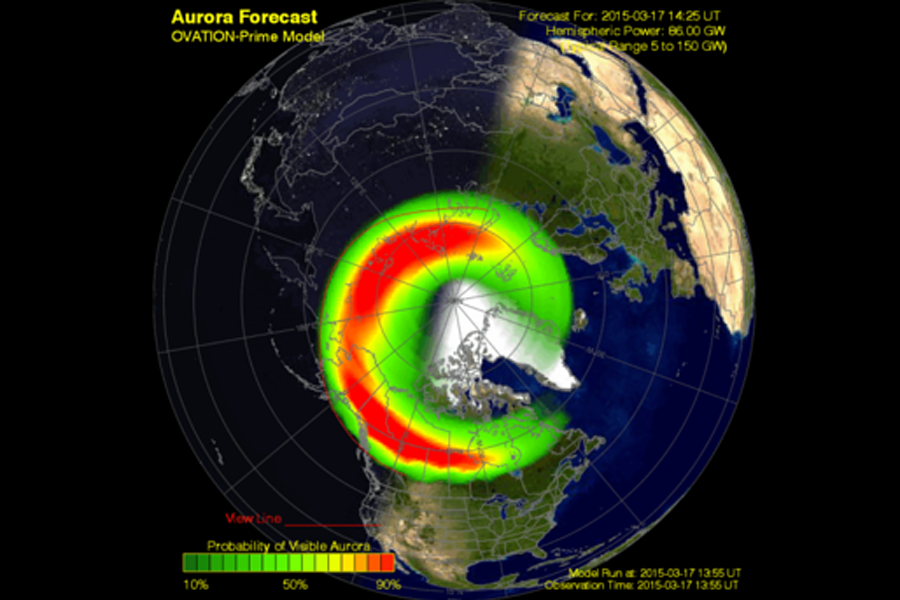On St. Patrick's Day, a dancing green aurora?
Loading...
A massive solar storm is bombarding Earth now, and it could super-charge the northern lights to offer a better chance of seeing dancing green auroras just in time for St. Patrick's Day, weather permitting.
The surprisingly strong solar storm — ranked as a G4 geomagnetic storm by NOAA's Space Weather Prediction Center — could trigger brilliant auroras for people in dark areas as far south as Tennessee tonight (March 17), if the space storm continues. The storm began at about 10 a.m. EDT (1400 GMT) today.
The G4 storm is not a danger to satellites or astronauts in space, but it could affect GPS and radio signals on Earth, space weather scientists with NOAA said in a press teleconference today. The solar storm has not been linked to any power outages on the planet, they added. (The most extreme geomagnetic storms are categorized as G5 storms in NOAA's system.) [See photos of the biggest solar flares of 2015]
"This is one of two severe geomagnetic storms that we have experienced during this current solar cycle," Thomas Berger, director of the Space Weather Prediction Center, said during the news conference.
The G4 storm is the result of two large eruptions that left the sun on Sunday, March 15. Two coronal mass ejections (huge explosions of super-hot solar plasma) directed toward Earth joined up while speeding through space, creating the large solar storm. The active region on the sun that spawned the eruptions is currently rotating out of view of the Earth.
NOAA officials expect that the solar storm should continue for at least the next several hours, but these types of storms are difficult to predict.
If the storm does continue, it's possible that people in northern Europe will have a great view of auroras tonight. United States stargazers might also be able to see the light show when darkness falls, assuming the storm continues.
Some skywatchers have already reported amazing views of the northern lights.
"We have heard of some very vivid sightings of aurora before the sun rose today," Brent Gordon, the Space Weather Prediction Center's space weather services branch chief said during the teleconference. "Aurora sightings were mainly confined to the northern tier of the United States — Minnesota, Wisconsin, both North and South Dakota as well as Washington State … and of course Alaska as well."
Geomagnetic storms are created when material shot from the sun interacts with Earth's magnetic field. The solar tempest can create incredible northern and southern lights displays, but it's also possible that the most severe of these storms could knock out power grids.
A powerful geomagnetic storm on Halloween in 2003 forced astronauts to seek shelter on the International Space Station because of potentially dangerous radiation levels. The Halloween storm also stressed power grids on the planet. Earth hasn't experienced a G4 storm since late 2013, Gordon said.
Visit NOAA's Space Weather Prediction Center website to find out if your area of the world might get the chance to see auroras today.
Editor's note:: If you take an amazing photo of the northern lights from the March 17 geomagnetic storm and you'd to share it for a possible story or image gallery, send images and comments in to managing editor Tariq Malik at spacephotos@space.com.
Follow Miriam Kramer @mirikramer. Follow us @Spacedotcom, Facebookand Google+. Original article onSpace.com.
- Poll: Have You Ever Seen the Northern Lights?
- Northern Lights Photos: Amazing Aurora Views of 2014
- Incoming! Powerful X2.2 Solar Flare Blasts Towards Earth | Video
Copyright 2015 SPACE.com, a Purch company. All rights reserved. This material may not be published, broadcast, rewritten or redistributed.







